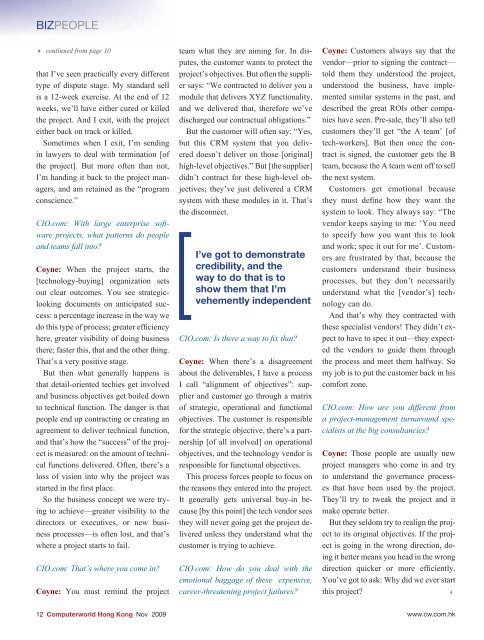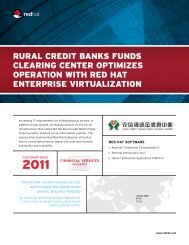Hong Kong Computer Society - enterpriseinnovation.net
Hong Kong Computer Society - enterpriseinnovation.net
Hong Kong Computer Society - enterpriseinnovation.net
You also want an ePaper? Increase the reach of your titles
YUMPU automatically turns print PDFs into web optimized ePapers that Google loves.
BIZPEOPLE<br />
4 continued from page 10<br />
that I’ve seen practically every different<br />
type of dispute stage. My standard sell<br />
is a 12-week exercise. At the end of 12<br />
weeks, we’ll have either cured or killed<br />
the project. And I exit, with the project<br />
either back on track or killed.<br />
Sometimes when I exit, I’m sending<br />
in lawyers to deal with termination [of<br />
the project]. But more often than not,<br />
I’m handing it back to the project managers,<br />
and am retained as the “program<br />
conscience.”<br />
CIO.com: With large enterprise software<br />
projects, what patterns do people<br />
and teams fall into?<br />
Coyne: When the project starts, the<br />
[technology-buying] organization sets<br />
out clear outcomes. You see strategiclooking<br />
documents on anticipated success:<br />
a percentage increase in the way we<br />
do this type of process; greater efficiency<br />
here, greater visibility of doing business<br />
there; faster this, that and the other thing.<br />
That’s a very positive stage.<br />
But then what generally happens is<br />
that detail-oriented techies get involved<br />
and business objectives get boiled down<br />
to technical function. The danger is that<br />
people end up contracting or creating an<br />
agreement to deliver technical function,<br />
and that’s how the “success” of the project<br />
is measured: on the amount of technical<br />
functions delivered. Often, there’s a<br />
loss of vision into why the project was<br />
started in the first place.<br />
So the business concept we were trying<br />
to achieve—greater visibility to the<br />
directors or executives, or new business<br />
processes—is often lost, and that’s<br />
where a project starts to fail.<br />
CIO.com: That’s where you come in?<br />
Coyne: You must remind the project<br />
team what they are aiming for. In disputes,<br />
the customer wants to protect the<br />
project’s objectives. But often the supplier<br />
says: “We contracted to deliver you a<br />
module that delivers XYZ functionality,<br />
and we delivered that, therefore we’ve<br />
discharged our contractual obligations.”<br />
But the customer will often say: “Yes,<br />
but this CRM system that you delivered<br />
doesn’t deliver on those [original]<br />
high-level objectives.” But [the supplier]<br />
didn’t contract for these high-level objectives;<br />
they’ve just delivered a CRM<br />
system with these modules in it. That’s<br />
the disconnect.<br />
I’ve got to demonstrate<br />
credibility, and the<br />
way to do that is to<br />
show them that I’m<br />
vehemently independent<br />
CIO.com: Is there a way to fix that?<br />
Coyne: When there’s a disagreement<br />
about the deliverables, I have a process<br />
I call “alignment of objectives”: supplier<br />
and customer go through a matrix<br />
of strategic, operational and functional<br />
objectives. The customer is responsible<br />
for the strategic objective, there’s a partnership<br />
[of all involved] on operational<br />
objectives, and the technology vendor is<br />
responsible for functional objectives.<br />
This process forces people to focus on<br />
the reasons they entered into the project.<br />
It generally gets universal buy-in because<br />
[by this point] the tech vendor sees<br />
they will never going get the project delivered<br />
unless they understand what the<br />
customer is trying to achieve.<br />
CIO.com: How do you deal with the<br />
emotional baggage of these expensive,<br />
career-threatening project failures?<br />
Coyne: Customers always say that the<br />
vendor—prior to signing the contract—<br />
told them they understood the project,<br />
understood the business, have implemented<br />
similar systems in the past, and<br />
described the great ROIs other companies<br />
have seen. Pre-sale, they’ll also tell<br />
customers they’ll get “the A team’ [of<br />
tech-workers]. But then once the contract<br />
is signed, the customer gets the B<br />
team, because the A team went off to sell<br />
the next system.<br />
Customers get emotional because<br />
they must define how they want the<br />
system to look. They always say: “The<br />
vendor keeps saying to me: ‘You need<br />
to specify how you want this to look<br />
and work; spec it out for me’. Customers<br />
are frustrated by that, because the<br />
customers understand their business<br />
processes, but they don’t necessarily<br />
understand what the [vendor’s] technology<br />
can do.<br />
And that’s why they contracted with<br />
these specialist vendors! They didn’t expect<br />
to have to spec it out—they expected<br />
the vendors to guide them through<br />
the process and meet them halfway. So<br />
my job is to put the customer back in his<br />
comfort zone.<br />
CIO.com: How are you different from<br />
a project-management turnaround specialists<br />
at the big consultancies?<br />
Coyne: Those people are usually new<br />
project managers who come in and try<br />
to understand the governance processes<br />
that have been used by the project.<br />
They’ll try to tweak the project and it<br />
make operate better.<br />
But they seldom try to realign the project<br />
to its original objectives. If the project<br />
is going in the wrong direction, doing<br />
it better means you head in the wrong<br />
direction quicker or more efficiently.<br />
You’ve got to ask: Why did we ever start<br />
this project? 3<br />
12 <strong>Computer</strong>world <strong>Hong</strong> <strong>Kong</strong> Nov 2009 www.cw.com.hk














